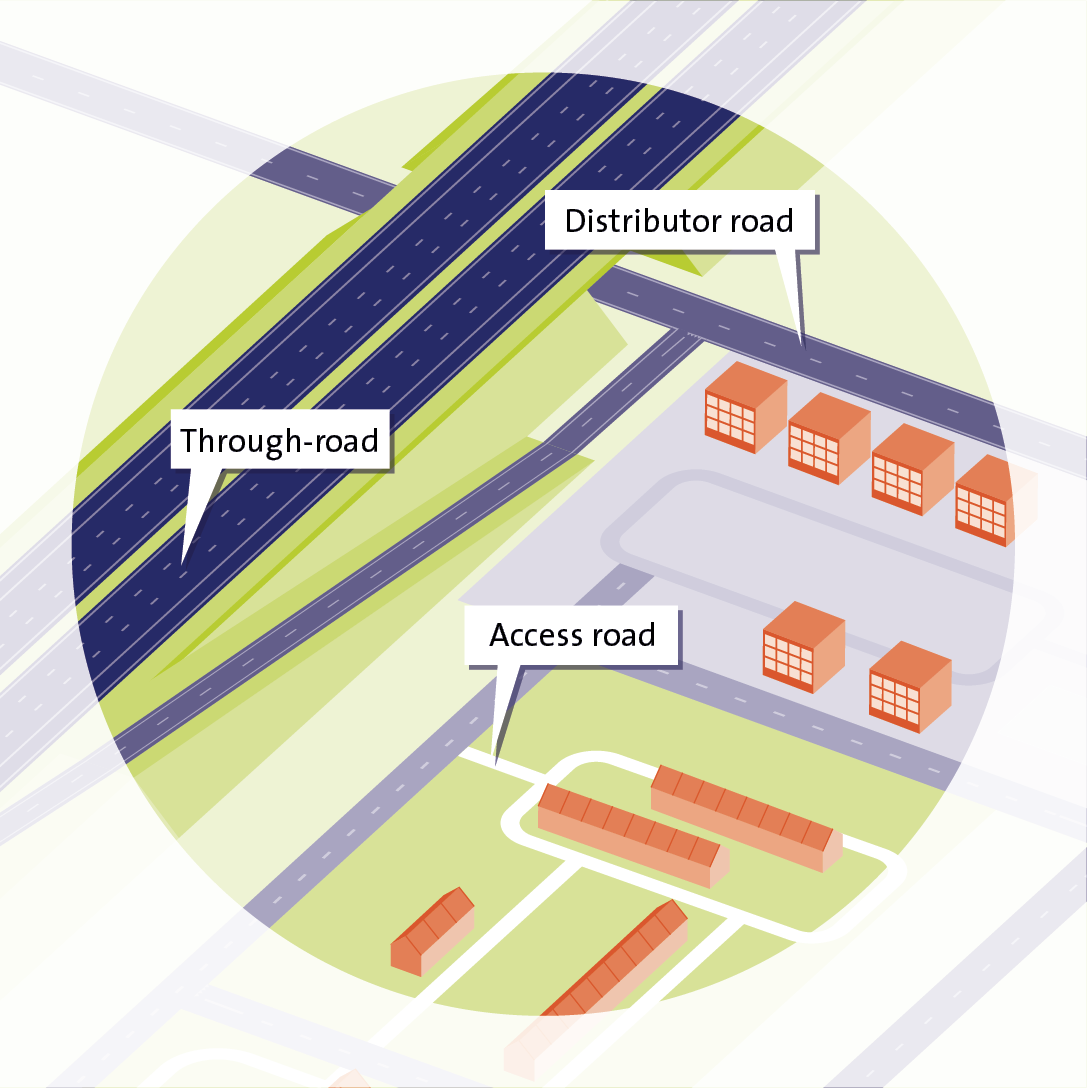Ideally, pedestrians and cyclists walk and cycle in 30km/h zones and home zones (15 km/h) or on physically separate footpaths/pavements and bicycle tracks along distributor roads (for ease of reference, hereafter referred to as 50 km/h roads). They may cross 50km/h-roads at intersections where speed is limited to 30 km/h. When there are crossings at road sections of 50km/h-roads, though, zebra crossings for instance, it is important that crossing traffic travels at a maximum speed of 30 km/h. Footpaths/pavements and bicycle tracks should be designed and maintained in such a way that chances of pedestrian falls or collisions and single-bicycle crashes are minimal, for example by not creating obstacles, and by means of sufficiently wide provisions and a plane road surface. Table 2 and Figure 5 summarise the Sustainably Safe road types and what the design principles of Sustainable Safety entail for an ideal design for pedestrians and cyclists.
|
Road type |
Speed limit |
Position of pedestrians and |
Position of pedestrians and cyclists for crossing |
|
Acces road |
15, 30 km/h |
Mingling with motor vehicles |
Everywhere |
|
Distributor road |
50, 70 km/h |
Separated by bicycle track or footpath |
Intersections or roundabouts |
|
Through-road |
100, 120 of 130 km/h |
Not allowed |
Grade-separated (tunnel or bridge) |
Table 2. Position of pedestrians and cyclists by road type according to Sustainable Safety.
 Figure 5. Functional road classification.
Figure 5. Functional road classification.
Infrastructure for safe interaction with motorised traffic
Sustainable Safety includes a.o. the design principles of functionality and (bio)mechanics, see SWOV fact sheet Sustainable Road Safety.
Functionality implies that mingling of and exchange between heavy motorised traffic, pedestrians and cyclists takes place in residential areas (with a speed limit of 15 or 30 km/h) and at intersections of distributor roads.
(Bio)mechanics implies that driving speeds are adapted to the most vulnerable road users, such as pedestrians and cyclists. At places where vulnerable road users mingle with heavy motorised traffic (in residential areas and at intersections), the speed limit is 30 km/h, because the risk of a fatal crash considerably increases when collision speed is higher than approximately 30 km/h [7]. At intersections where pedestrians and cyclists may meet heavy motorised traffic, the ideal speed limit is therefore 30 km/h. This could be enforced by means of raised intersections [8] or roundabouts (see SWOV fact sheet Roundabouts). On 50km/h-roads, pedestrians and cyclists should be physically separated from motorised traffic by means of footpaths and bicycle tracks. These roads are crossed by means of intersections because driving speed at road sections is too high. The location of important walking routes and main cycling routes implies that 50km/h-road sections may also need crossing facilities.
The Administrative Provisions Decree determines that, in the urban area, roads with a 30km/h- or 50km/h-speed limit should have zebra crossings. The risks of high speeds at road sections have resulted in Recommendations for Urban Road Facilities and other CROW publications [9] [10] [11] restricting the use of zebra crossings to certain conditions (for example, only at those locations where a relatively large number of pedestrians cross the road) and to add countermeasures (such as lowering the speed of motorised traffic at the crossing location to a limit of 30km/h and to add a plateau). In 30km/h-zones, zebra crossings are, in principle, not implemented, because a credible road design implies that safe crossing should be possible at every zone location.
Infrastructure for preventing pedestrian falls or collisions
Compared to the cycling infrastructure, little attention has yet been paid to the pedestrian infrastructure to prevent falls, since these are not defined as road crashes. However, requirements to make footpaths accessible to groups such as wheelchair users, blind and visually impaired road users have been set. Examples of requirements from the Accessibility manual [12] are wide footpaths, sufficiently large storage areas on median islands and entry and exit ramps for wheelchair accessibility. As yet, too little research is available to allow for solid conclusions, but improving accessibility is likely to also help prevent pedestrian falls. Research into these falls and collisions suggests that steps, loose flagstones, potholes, winter slipperiness, and litter play a role [1] [13].
To prevent single-bicycle crashes, it is important that there are no obstacles to crash into, that road alignment is visually guided with edge and centre line markings for bicycle tracks for instance, that the infrastructure is sufficiently wide, that the road surface is even, skid-resistant, free of cracks and clean, and that road shoulders and kerbs are forgiving [14] [15] [16]. Details of the design principles for safe bicycle tracks have been published in ‘Components for a comfortable and forgiving bicycle track’ [17].
